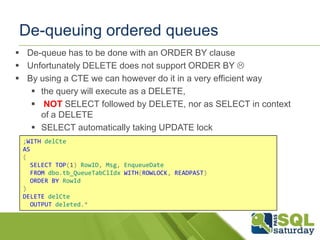Queuing Sql Server: Utilise queues to increase performance in SQL Server
- 1. Messages & Queues in SQL Server Enhance performance by using queues in SQL Server
- 2. Bio - Niels Berglund Software Specialist - Derivco Software Specialist - lots of production dev. plus figuring out ways to "use and abuse" existing and new technologies Author - "First Look at SQL Server 2005 for Developers" Researcher / Instructor - DevelopMentor Speaker - TechEd, DevWeek, SQL Pass, etc. Longtime user of SQL Server www.derivco.com [email protected] @nielsberglund 2 | 10/28/201 Footer Goes Here 3 |
- 3. Derivco World's leading development house for online gaming software; Casino, Poker, Bingo etc. Offices in Durban, Cape Town, Pretoria (soon) Estonia, Hong Kong, Sweden, UK Technology company One of the world's largest install base of SQL Server's (~300 SQL Server servers, multiple instances & db's). SQL Server 2008 / 2012, research into 2014 Hadoop, Windows Azure .NET 4.5, SignalR, WebSockets, mobile (Android, iOS) WE ARE HIRING
- 4. Disclaimer I really, really like Service Broker!! Honest, I Do!
- 5. Background In certain scenarios beneficial to off-load work to other processes/threads. In SQL Server we have no real way to control threading Historically difficult to create messaging applications in SQL Server, due to queuing is highly concurrent. how do we ensure that multiple consumers does not block each other how do we de-queue without causing deadlocks etc. SQL Server 2005 introduced new functionality which makes it easier to remove a de-queued row and return it to the caller in one atomic statement: DELETE TOP(x) OUTPUT statement
- 6. De-queuing old vs. new --old way DECLARE @tab TABLE(RowID bigint, MsgTypeID int, Msg varchar(500), EnqueueDate datetime2) INSERT INTO @tab SELECT TOP (1) * FROM dbo.tb_QueueTabClIdx WITH(UPDLOCK, READPAST) DELETE clix FROM dbo.tb_QueueTabClIdx clix JOIN @tab t ON clix.RowID = t.RowID --new way DECLARE @tab TABLE(RowID bigint, MsgTypeID int, Msg varchar(500), EnqueueDate datetime2) DELETE TOP(1) dbo.tb_QueueTabClIdx WITH(ROWLOCK, READPAST) OUTPUT deleted.RowID, deleted.MsgTypeID, deleted.Msg, deleted.EnqueueDate INTO @tab(RowID, MsgTypeID, Msg, EnqueueDate)
- 7. Queue types Heap queue backed by heap table heap table is a table with no clustered index cannot guarantee order of en-queue, de-queue useful for specific queuing scenarios beware of side effects (data growth) Ordered queue (FIFO, LIFO) First In First Out, Last In First Out in LIFO queues beware of hot-spots (inserting, deleting same group of rows) backed by table with clustered index (can be non-unique or unique) de-queuing has to be done with an ORDER BY clause SQL Server Service Broker Queue (SSB Queue) Bound queues (more later)
- 8. De-queuing ordered queues De-queue has to be done with an ORDER BY clause Unfortunately DELETE does not support ORDER BY By using a CTE we can however do it in a very efficient way the query will execute as a DELETE, NOT SELECT followed by DELETE, nor as SELECT in context of a DELETE SELECT automatically taking UPDATE lock ;WITH delCte AS ( SELECT TOP(1) RowID, Msg, EnqueueDate FROM dbo.tb_QueueTabClIdx WITH(ROWLOCK, READPAST) ORDER BY RowId ) DELETE delCte OUTPUT deleted.*
- 9. SSB queues SSB allows internal or external processes to send and receive guaranteed, asynchronous messages by using extensions to DML It has the concept of queues, meant for use by SSB When using it in a "normal" queuing application, it has several short-comings: convoluted way to en-queue messages rigid structure performance One big plus though: Activation stored procedure that automatically is activated when a message is en-queued on the SSB queue. can control concurrency
- 10. Performance I Multiple producers running concurrently One consumer running in parallel Each producer en-queuing one record running in a tight loop, 10,000 times Consumer started together with the producers, de-queuing until no more data.
- 12. Bound queues High volume inserts/deletes causes problems in a db: heap table unlimited growth statistics are never up to date auto updates of statistics constantly kicking in, creating jagged CPU patterns and throughput new pages constantly allocated, de-allocated stresses internal allocation structures Quite a few high performing queuing applications are using a bound queue in a ringbuffer scenario minimizes memory allocation, de-allocation
- 13. Table backing ring-buffer CREATE TABLE dbo.tb_QueueTabRingBuffer ( MsgSlot BIGINT NOT NULL , MessageID BIGINT NULL , MsgTypeID int NULL , EnqueueDate datetime2 NOT NULL , Msg char(500) NOT NULL , ReferenceCount TINYINT NOT NULL )
- 14. Using a ring-buffer like table After creation of table, prefill with data (keep track of how many rows inserted) To enqueue: create a new message id find the next available slot update the message column and add one to the reference count To de-queue find the smallest message id that has not yet been de-queued. read and return the message column decrement reference count, marking the slot as available. We need to be able to extremely efficiently locate the next available slot For this we use a sequence object
- 15. Sequence object A high scale data structure to generate "next number" quite a few "neat" features Introduced in SQL Server 2012 When used in conjunction with the modulo operator (%) we can efficiently get next slot etc. CREATE SEQUENCE dbo.seq_Test AS BIGINT START WITH 1 INCREMENT BY 1 CACHE 5000; GO SELECT NEXT VALUE FOR dbo.seq_Test;
- 16. En-queuing When en-queuing into a ring-buffer, the en-queue may block if no available slots. Need to handle that in en-queue code (not shown below) DECLARE DECLARE DECLARE DECLARE @enqueuSequence bigint; @slot int; @QueueSize int = 5000; @msg char(500) = 'this is a new message'; --grab the next value, and slot SET @enqueuSequence = NEXT VALUE FOR dbo.seq_Enqueue; SET @Slot = @enqueuSequence % @QueueSize --do the update UPDATE dbo.tb_QueueTabRingBuffer WITH(ROWLOCK) SET EnqueueDate = SYSDATETIME(), Msg = @Msg, MessageID = @enqueuSequence, MsgTypeID = 2, ReferenceCount = 1 WHERE MsgSlot = @Slot AND ReferenceCount = 0
- 17. De-queuing De-queuing is similar to en-queue. Need however to ensure that the de-queue sequence does not out of synch with the en-queue. DECLARE @dequeuSequence bigint; DECLARE @slot int; DECLARE @queueSize int = 5000; --grab the next MessageID, and slot SET @dequeuSequence = NEXT VALUE FOR dbo.seq_Dequeue; SET @Slot = @dequeuSequence % @QueueSize UPDATE dbo.tb_QueueTabRingBuffer WITH(ROWLOCK) SET EnqueueDate = SYSDATETIME(), MessageID = NULL, MsgTypeID = NULL , Msg = 'dummy', ReferenceCount = 0 OUTPUT deleted.* WHERE MsgSlot = @Slot AND MessageID = @dequeuSequence AND ReferenceCount = 1;
- 19. Summary Implementing efficient queuing in SQL Server is definitely doable SQL Server 2008R2 the best table structure for overall performance is a queue backed by clustered non-unique index for certain specialized scenarios a heap-table can come into play (beware of data growth) SQL Server 2012 a ring-buffer like structure using sequence objects are the absolutely best performing table structure beware of more convoluted code to keep the en-queue and dequeue in synch SQL Server Service Broker too convoluted, not enough performance activation procedures its strong point
Editor's Notes
- #2: Do not take any notice of the absolute numbers - the tests run on a low-end machine, in a VM. Look at the relations between the various structures.
- #3: Do not take any notice of the absolute numbers - the tests run on a low-end machine, in a VM. Look at the relations between the various structures.



















